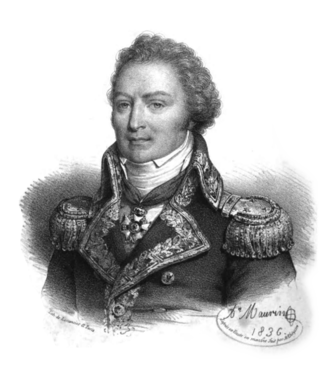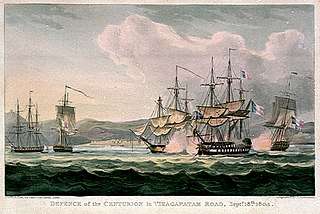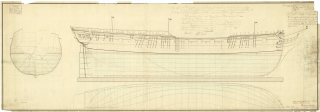
Jean-Baptiste Perrée was a French Navy officer and Rear-admiral.

The Redoutable was a Téméraire-class 74-gun ship of the line of the French Navy. She took part in the battles of the French Revolutionary Wars in the Brest squadron, served in the Caribbean in 1803, and duelled with HMS Victory during the Battle of Trafalgar, killing Vice Admiral Horatio Nelson during the action. She sank in the storm that followed the battle.

Louis-René Madelaine Le Vassor, comte de La Touche-Tréville was a French admiral. He fought in the American War of Independence and became a prominent figure of the French Revolutionary Wars and of the Napoleonic wars.

Count Honoré Joseph Antoine Ganteaume was a French Navy officer and Vice-admiral.

Protecteur was a Souverain-class 74-gun ship of the line of the French Navy, the only to have borne the name.

Jean-Baptiste Philibert Willaumez was a French naval officer and nobleman who served during the French Revolutionary Wars and Napoleonic Wars. Willaumez joined the French Navy at the age of 14, and proved to be a competent sailor. Having risen to the rank of pilot, he started studying navigation, attracting the attention of his superiors up to Louis XVI himself. Willaumez eventually became an officer and served under Antoine Bruni d'Entrecasteaux in his expedition to rescue Jean-François de Galaup, comte de Lapérouse and explore the Indian Ocean and Oceania.

The Sémillante was a 32-gun frigate of the French Navy and the lead ship of her class. She was involved in a number of multi-vessel actions against the Royal Navy, particularly in the Indian Ocean. She captured a number of East Indiamen before she became so damaged that the French disarmed her and turned her into a merchant vessel. The British captured her and broke her up in 1809.

Pomone was a 40-gun frigate of the French Navy, launched in 1785. The British captured her off the Île de Batz in April 1794 and incorporated her into the Royal Navy. Pomone subsequently had a relatively brief but active career in the British Navy off the Atlantic and Mediterranean coasts of France before suffering sufficient damage from hitting a rock. Due to this, the ship was taken out of service and then broken up in 1803.

Jean François Renaudin was a French Navy officer and Rear-Admiral. He is mostly known for captaining the Vengeur du Peuple at the Fourth Battle of Ushant.

Pierre-François-Henri-Étienne Bouvet de Maisonneuve was a French Navy officer and privateer.
Harmonie was a 40-gun Virginie-class frigate of the French Navy. Her crew scuttled her on 17 March 1797 to avoid having the Royal Navy capture her. She on being burned was reported as pierced for 44 guns

The Third Battle of Ushant or the action of 20–21 April 1782 was a naval battle fought during the American Revolutionary War, between a French naval fleet of three ships of the line protecting a convoy and two British Royal naval ships of the line off Ushant, a French island at the mouth of the English Channel off the northwesternmost point of France. This was the third battle that occurred in this region during the course of the war.

Gracieuse was a 32-gun Charmante-class frigate of the French Navy. Renamed to Unité in 1793, she took part in the French Revolutionary Wars. The Royal Navy captured her in 1796 off Île d'Yeu and brought her into British service as HMS Unite. She was sold in 1802

The action of 28 June 1803 marked the opening shots of the Blockade of Saint-Domingue after the collapse of the Treaty of Amiens and the outbreak of the War of the Third Coalition in May 1803.

Louis-Charles-Auguste Delamarre, vicomte de Lamellerie was a French Navy officer and captain.
Amand Leduc was a French sailor and Navy officer of the First French Empire.

Théobald-René, Comte de Kergariou-Locmaria was a French Navy officer and Royalist émigré.
The French ship Généreux was originally the Portuguese merchantman Ouvidor Pereira. Captured by Entreprenant in 1809, the French navy took her into service as Généreux. In 1814 she was renamed Loire. She was decommissioned at Brest in July 1838 and struck from the lists in August before being broken up.

HMS Sylph was a 16-gun Albatross-class brig-sloop of the Royal Navy designed by William Rule and launched in 1795 at Deptford Dockyard. Her namesake was the air spirit sylph. She commissioned in August 1795 under Commander John Chambers White, who would have her until the end of 1799. She was later commanded by Charles Dashwood.

HMS Artois was a fifth-rate Artois-class frigate of the Royal Navy, designed by Sir John Henslow and launched in 1794 at Rotherhithe as the lead ship of her class. She served for the majority of her career in the English Channel under the command of Edmund Nagle in the squadrons of Edward Pellew and John Borlase Warren, notably taking part in the action of 21 October 1794 where she captured the 44-gun frigate La Révolutionnaire almost singlehandedly. She participated in a number of other actions and events including the attempted invasion of France in 1795. Artois continued to serve actively on the coast of France in blockade and patrolling roles, taking a large number of ships as prizes, until she was wrecked with no loss of life off Île de Ré on 31 July 1797 while attempting to reconnoitre the harbour of La Rochelle.
















